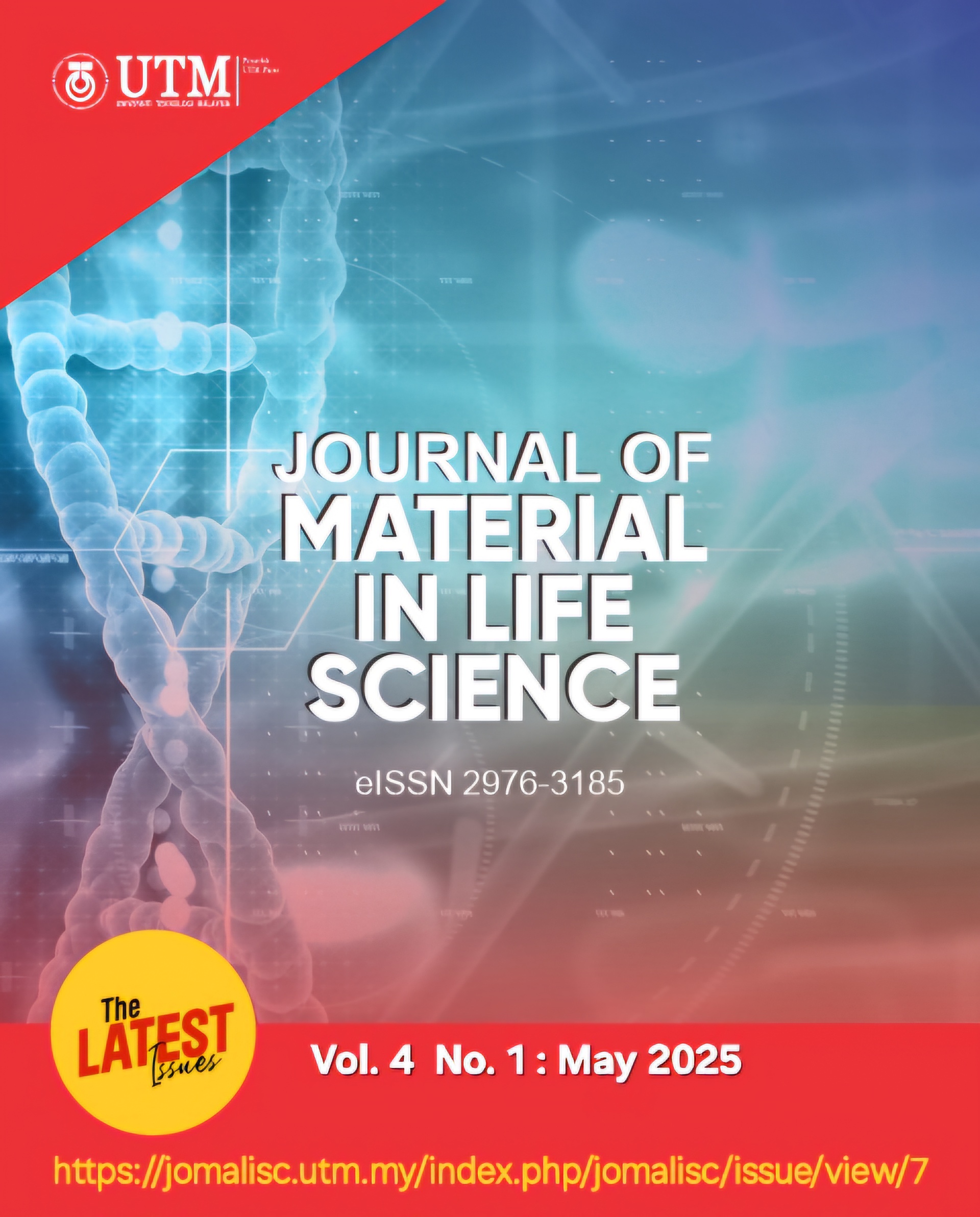Biosorption Mechanism of Cadmium by Acid-treated Non-living Rhodopseudomonas sp. strain SBL
DOI:
https://doi.org/10.11113/jomalisc.v4.85Keywords:
biosorption, adsorption mechanism, cadmium, Rhodopseudomonas sp.Abstract
This research aimed to evaluate the effects of initial cadmium concentration and contact time on the biosorption capacity of cadmium by acid-treated non-living Rhodopseudomonas sp. strain SBL, to analyse the mechanism of the biosorption by kinetic models, and to characterise the morphological and functional group changes of Rhodopseudomonas sp. strain SBL in the biosorption process. The biosorption capacity of cadmium was quantitatively evaluated using an Atomic Absorption Spectrophotometer (AAS). The data was then subjected to pseudo-first-order and pseudo-second-order models to analyse the mechanism of the biosorption process. The changes in the morphological and functional group of Rhodopseudomonas sp. strain SBL in the biosorption process were observed using Scanning Electron Microscopy (SEM) and Fourier Transform Infrared Spectroscopy (FTIR). The effect of initial cadmium concentration showed that the percentage biosorption decreased with increasing initial cadmium concentration, where an initial cadmium concentration of 0.5 mg/L gave the highest biosorption capacity of 77.5%. The effect of contact time revealed that the percentage biosorption increased with contact time and reached equilibrium after 30 minutes. The optimal contact time is at minute 30, with a biosorption capacity of 68.5%. In the biosorption kinetic study, the data obtained fit the pseudo-second-order model, indicating that the biosorption process occurs via chemisorption. The observation under SEM showed morphological changes of Rhodopseudomonas sp. strain SBL from smooth to rough surfaces, with the formation of pores following the biosorption process. The FTIR analysis showed hydroxyl, carbonyl, and carboxyl groups as the main functional groups involved in the biosorption process. The findings in this study suggested that the acid-treated non-living Rhodopseudomonas sp. strain SBL has a promising potential as a biosorbent for the removal of cadmium via biosorption.
References
Abdel -Aty, A. M., Ammar, N. S., Abdel Ghafar, H. H., & Ali, R. K. 2013. Biosorption of cadmium and lead from aqueous solution by fresh water alga Anabaena sphaerica biomass. Journal of Advanced Research, 4(4), 367–374.
Arief, V. O., Trilestari, K., Sunarso, J., Indraswati, N., & Ismadji, S. 2008. Recent Progress on Biosorption of Heavy Metals from Liquids Using Low Cost Biosorbents: Characterization, Biosorption Parameters and Mechanism Studies. CLEAN – Soil, Air, Water, 36(12), 937–962.
Asadi Haris, S., Altowayti, W. A. H., Ibrahim, Z., & Shahir, S. 2018. Arsenic biosorption using pretreated biomass of psychrotolerant Yersinia sp. strain SOM-12D3 isolated from Svalbard, Arctic. Environmental Science and Pollution Research, 25(28), 27959–27970.
Atlas, H., Sadoq, M., Imame, S., Amar, A., Kali, A., Loulidi, I., Mamouni, F. Z., Jabri, M., Chaimaa, H., Bennani, M. N., Sannasi, A. P., & Boukhlifi, F. 2023. Sustainable biosorption of Methylthioninium Chloride in wastewaters using new Cystoseira barbata seaweed: Equilibrium isotherm, kinetic modeling and mechanism analysis.
Chakravarty, R., & Banerjee, P. C. 2008. Morphological changes in an acidophilic bacterium induced by heavy metals. Extremophiles, 12(2), 279–284.
Charles, C., & Rini, D. S. 2018. Cadmium contamination and the role of bioaccumulator plant as a remediation agent. AIP Conference Proceedings, 2014(1), 20126.
Chauhan, R., Patel, H., & Rawat, S. 2020. Biosorption of Carcinogenic Heavy Metals by Bacteria: Role and Mechanism. Removal of Emerging Contaminants through Microbial Processes, 237–263.
Chen, H., Dai, G., Zhao, J., Zhong, A., Wu, J., & Yan, H. 2010. Removal of copper(II) ions by a biosorbent—Cinnamomum camphora leaves powder. Journal of Hazardous Materials, 177(1–3), 228–236.
Dhar, K., Venkateswarlu, K., & Megharaj, M. 2023. Anoxygenic phototrophic purple non-sulfur bacteria: tool for bioremediation of hazardous environmental pollutants. World Journal of Microbiology & Biotechnology, 39(10).
Farhan, A. M., Al-Dujaili, A. H., & Awwad, A. M. 2013. Equilibrium and kinetic studies of cadmium(II) and lead(II) ions biosorption onto Ficus carcia leaves. International Journal of Industrial Chemistry 2013 4:1, 4(1), 1–8.
Farhan, S. N., & Khadom, A. A. 2015. Biosorption of heavy metals from aqueous solutions by Saccharomyces Cerevisiae. International Journal of Industrial Chemistry, 6(2), 119–130.
Ghasemi, M., Naushad, M., Ghasemi, N., & Khosravi-fard, Y. 2014. Adsorption of Pb(II) from aqueous solution using new adsorbents prepared from agricultural waste: Adsorption isotherm and kinetic studies. Journal of Industrial and Engineering Chemistry, 20(4), 2193–2199.
Hariharan, A., Harini, V., Sandhya, S., & Rangabhashiyam, S. 2023. Waste Musa acuminata residue as a potential biosorbent for the removal of hexavalent chromium from synthetic wastewater. Biomass Conversion and Biorefinery, 13(2), 1297–1310.
Li, X., Li, D., Yan, Z., & Ao, Y. 2018. Biosorption and bioaccumulation characteristics of cadmium by plant growth-promoting rhizobacteria. RSC Advances, 8(54), 30902–30911.
Li, X., Xiao, Q., Shao, Q., Li, X., Kong, J., Liu, L., Zhao, Z., & Li, R. 2023. Adsorption of Cd (II) by a novel living and non-living Cupriavidus necator GX_5: optimization, equilibrium and kinetic studies. BMC Chemistry, 17(1), 1– 14.
Li, Y., Wei, Y., Huang, S., Liu, X., Jin, Z., Zhang, M., Qu, J., & Jin, Y. 2018. Biosorption of Cr(VI) onto Auricularia auricula dreg biochar modified by cationic surfactant: Characteristics and mechanism. Journal of Molecular Liquids, 269, 824–832.
Ma, X., Cui, W., Yang, L., Yang, Y., Chen, H., & Wang, K. 2015. Efficient biosorption of lead(II) and cadmium(II) ions from aqueous solutions by functionalized cell with intracellular CaCO3 mineral scaffolds. Bioresource Technology, 185, 70–78.
Mandal, A., Dey, B. B., & Das, S. K. 2020. Thermodynamics, kinetics, and isotherms for phenol removal from wastewater using red mud. Water Practice and Technology, 15(3), 705–722.
Moustafa, T., Abbas, S. H., Ismail, I. M., Mostafa, T. M., & Sulaymon, A. H. 2014. Biosorption of Heavy Metals Biosorption of Heavy Metals: A Review (Vol. 3, Issue 4).
Mukkata, K., Kantachote, D., Wittayaweerasak, B., Megharaj, M., & Naidu, R. 2019. The potential of mercury resistant purple nonsulfur bacteria as effective biosorbents to remove mercury from contaminated areas. Biocatalysis and Agricultural Biotechnology, 17, 93–103.
Nagy, B., Tonk, S., Indolean, C., Măicăneanu, A., Majdik, C., Nagy, B., Tonk, S., Indolean, C., Măicăneanu, A., & Majdik, C. 2013. Biosorption of Cadmium Ions by Unmodified, Microwave and Ultrasound Modified Brewery and Pure Strain Yeast Biomass. American Journal of Analytical Chemistry, 4(7), 63–71.
Nguyen, K. Q., Kantachote, D., Onthong, J., & Sukhoom, A. 2018. Al3+ and Fe2+ toxicity reduction potential by acid-resistant strains of Rhodopseudomonas palustris isolated from acid sulfate soils under acidic conditions. Annals of Microbiology, 68(4), 217–228.
Nithya, C., Gnanalakshmi, B., & Pandian, S. K. 2011. Assessment and characterization of heavy metal resistance in Palk Bay sediment bacteria. Marine Environmental Research, 71(4), 283–294.
Özer, A., Özer, D., & Özer, A. 2004. The adsorption of copper(II) ions on to dehydrated wheat bran (DWB): determination of the equilibrium and thermodynamic parameters. Process Biochemistry, 39(12), 2183–2191.
Pande, V., Pandey, S. C., Sati, D., Bhatt, P., & Samant, M. 2022. Microbial Interventions in Bioremediation of Heavy Metal Contaminants in Agroecosystem. Frontiers in Microbiology, 13, 824084.
Panwichian, S., Kantachote, D., Wittayaweerasak, B., & Mallavarapu, M. 2010. Isolation of purple nonsulfur bacteria for the removal of heavy metals and sodium from contaminated shrimp ponds. Electronic Journal of Biotechnology, 13(4).
Petrović, M., Šoštarić, T., Stojanović, M., Milojković, J., Mihajlović, M., Stanojević, M., & Stanković, S. 2016. Removal of Pb2+ ions by raw corn silk (Zea mays L.) as a novel biosorbent. Journal of the Taiwan Institute of Chemical Engineers, 58, 407–416.
Ramrakhiani, L., Ghosh, S., Sarkar, S., & Majumdar, S. 2016. Heavy metal biosorption in multi component system on dried activated sludge: investigation of adsorption mechanism by surface characterization. Materials Today: Proceedings, 3(10), 3538–3552.
Roșca, M., Silva, B., Tavares, T., & Gavrilescu, M. 2023. Biosorption of Hexavalent Chromium by Bacillus megaterium and Rhodotorula sp. Inactivated Biomass. Processes 2023, Vol. 11, Page 179, 11(1), 179.
Saif, M. M. S., Kumar, N. S., & Prasad, M. N. V. 2012. Binding of cadmium to Strychnos potatorum seed proteins in aqueous solution: Adsorption kinetics and relevance to water purification. Colloids and Surfaces B: Biointerfaces, 94, 73– 79.
Satya, A., Harimawan, A., Haryani, G. S., Johir, M. A. H., Vigneswaran, S., Ngo, H. H., & Setiadi, T. 2020. Batch Study of Cadmium Biosorption by Carbon Dioxide Enriched Aphanothece sp. Dried Biomass. Water 2020, Vol. 12, Page 264, 12(1), 264.
Shah, J., Jan, M. R., Haq Atta Ul, A. U., & Sadia, M. 2011. Biosorption of cadmium from aqueous solution using mulberry wood sawdust: Equilibrium and kinetic studies. Separation Science and Technology, 46(10), 1631–1637.
Shen, L., Chen, R., Wang, J., Fan, L., Cui, L., Zhang, Y., Cheng, J., Wu, X., Li, J., & Zeng, W. 2021. Biosorption behavior and mechanism of cadmium from aqueous solutions by Synechocystis sp. PCC6803. RSC Advances, 11(30), 18637–18650.
Wan Ngah, W. S., Kamari, A., & Koay, Y. J. 2004. Equilibrium and kinetics studies of adsorption of copper (II) on chitosan and chitosan/PVA beads. International Journal of Biological Macromolecules, 34(3), 155–161.
Xie, R., Wang, H., Chen, Y., & Jiang, W. 2013. Walnut shell-based activated carbon with excellent copper (II) adsorption and lower chromium (VI) removal prepared by acid–base modification. Environmental Progress & Sustainable Energy, 32(3), 688–696.


















